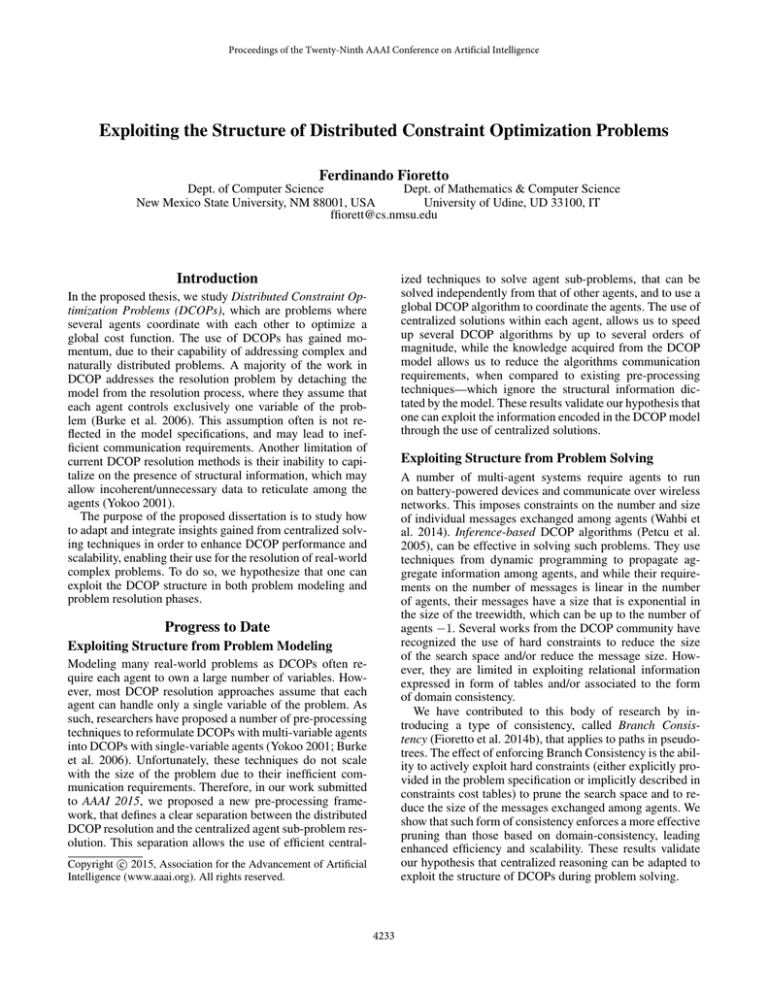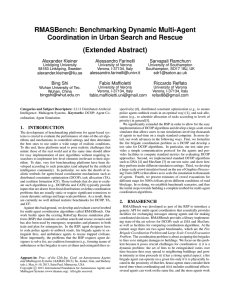
Proceedings of the Twenty-Ninth AAAI Conference on Artificial Intelligence
Exploiting the Structure of Distributed Constraint Optimization Problems
Ferdinando Fioretto
Dept. of Computer Science
Dept. of Mathematics & Computer Science
New Mexico State University, NM 88001, USA
University of Udine, UD 33100, IT
ffiorett@cs.nmsu.edu
Introduction
ized techniques to solve agent sub-problems, that can be
solved independently from that of other agents, and to use a
global DCOP algorithm to coordinate the agents. The use of
centralized solutions within each agent, allows us to speed
up several DCOP algorithms by up to several orders of
magnitude, while the knowledge acquired from the DCOP
model allows us to reduce the algorithms communication
requirements, when compared to existing pre-processing
techniques—which ignore the structural information dictated by the model. These results validate our hypothesis that
one can exploit the information encoded in the DCOP model
through the use of centralized solutions.
In the proposed thesis, we study Distributed Constraint Optimization Problems (DCOPs), which are problems where
several agents coordinate with each other to optimize a
global cost function. The use of DCOPs has gained momentum, due to their capability of addressing complex and
naturally distributed problems. A majority of the work in
DCOP addresses the resolution problem by detaching the
model from the resolution process, where they assume that
each agent controls exclusively one variable of the problem (Burke et al. 2006). This assumption often is not reflected in the model specifications, and may lead to inefficient communication requirements. Another limitation of
current DCOP resolution methods is their inability to capitalize on the presence of structural information, which may
allow incoherent/unnecessary data to reticulate among the
agents (Yokoo 2001).
The purpose of the proposed dissertation is to study how
to adapt and integrate insights gained from centralized solving techniques in order to enhance DCOP performance and
scalability, enabling their use for the resolution of real-world
complex problems. To do so, we hypothesize that one can
exploit the DCOP structure in both problem modeling and
problem resolution phases.
Exploiting Structure from Problem Solving
A number of multi-agent systems require agents to run
on battery-powered devices and communicate over wireless
networks. This imposes constraints on the number and size
of individual messages exchanged among agents (Wahbi et
al. 2014). Inference-based DCOP algorithms (Petcu et al.
2005), can be effective in solving such problems. They use
techniques from dynamic programming to propagate aggregate information among agents, and while their requirements on the number of messages is linear in the number
of agents, their messages have a size that is exponential in
the size of the treewidth, which can be up to the number of
agents −1. Several works from the DCOP community have
recognized the use of hard constraints to reduce the size
of the search space and/or reduce the message size. However, they are limited in exploiting relational information
expressed in form of tables and/or associated to the form
of domain consistency.
We have contributed to this body of research by introducing a type of consistency, called Branch Consistency (Fioretto et al. 2014b), that applies to paths in pseudotrees. The effect of enforcing Branch Consistency is the ability to actively exploit hard constraints (either explicitly provided in the problem specification or implicitly described in
constraints cost tables) to prune the search space and to reduce the size of the messages exchanged among agents. We
show that such form of consistency enforces a more effective
pruning than those based on domain-consistency, leading
enhanced efficiency and scalability. These results validate
our hypothesis that centralized reasoning can be adapted to
exploit the structure of DCOPs during problem solving.
Progress to Date
Exploiting Structure from Problem Modeling
Modeling many real-world problems as DCOPs often require each agent to own a large number of variables. However, most DCOP resolution approaches assume that each
agent can handle only a single variable of the problem. As
such, researchers have proposed a number of pre-processing
techniques to reformulate DCOPs with multi-variable agents
into DCOPs with single-variable agents (Yokoo 2001; Burke
et al. 2006). Unfortunately, these techniques do not scale
with the size of the problem due to their inefficient communication requirements. Therefore, in our work submitted
to AAAI 2015, we proposed a new pre-processing framework, that defines a clear separation between the distributed
DCOP resolution and the centralized agent sub-problem resolution. This separation allows the use of efficient centralc 2015, Association for the Advancement of Artificial
Copyright Intelligence (www.aaai.org). All rights reserved.
4233
Exploiting Structure from Both Problem Modeling
and Problem Solving
et al. 2007). Such a DCOP language is (a) more expressive
than other adopted formalisms (such as XML-based DCOP
descriptions) and (b) it allows the expression of constraints
succinctly, in the form of rules, using a well adopted semantics from the constraint reasoning community and allows a
fine integration with agents’ centralized solvers. Our preliminary results show that such a representation may significantly affect performance, due to the stronger inference that
may be derived from explicit constraint representation.
We are also implementing a DCOP solver that uses agent
distributed over different machines, and can communicate
using several network standard communication protocols
(TCP-IP, wireless, etc.). We believe that this is a valuable
contribution, as current DCOP simulators suffer from strong
communication assumptions (e.g., they assume the same
cost for all communications, and direct communications,
with no routing), which may not fully reflect the DCOP algorithm behavior on real scenarios (Wahbi et al. 2014).
Leastly, we plan to apply the techniques produced in the
proposed thesis on smart grid domains, where we model
a network of building (e.g., homes, offices, power plants),
each of which is managed by an agent, with its own power
demands, including generators (e.g., solar panels, gas-based
generators) and accumulators (e.g., batteries, electric vehicles). One of the problem that we plan to study is that of
finding (sub-)optimal schedule for the local energy dispatch.
The separation between the DCOP resolution process and
the centralized agent problem, which was gained by exploiting the problem model, enabled agents to solve their local
problem trough a variety of techniques. Motivated by the
high complexity of the agent local problem, we proposed
the use of hierarchical parallel models, where each agent
can (a) solve its local problem independently from those of
other agents, and (b) parallelize the computations within its
own local problem. Such model builds on top of algorithmspecific characteristics, and may substantially reduces the
runtime for several DCOP algorithms classes. For instance,
in (Fioretto et al. 2014a), we suggest to solve independent
local problems, in parallel, harnessing the multitude of computational units offered by GPGPUs, which led to significant
improvements in the runtime of the algorithm resolution.
Proposed Plan for the Future
Efficient Local Search Strategies for DCOPs
In the work conducted so far we adapted centralized reasoning techniques to complete DCOP algorithms. Nevertheless, solving DCOPs optimally is NP-hard, therefore for
large problems, incomplete DCOP algorithms are desirable.
Current incomplete search techniques can either (a) find local minima without quality guarantees (Maheswaran et al.
2004), (b) provide quality assessment but inefficiently (such
us those in the class of k-optimality (Pearce et al. 2007)), (c)
cannot exploit problem structural information, such as hard
constraints (Nguyen et al. 2013).
Therefore, capitalizing on strategies from the centralized
constraint reasoning community, we propose to adapt the
Large Neighboring Search strategy (LNS) (Van Hentenryck
et al. 2009) to the DCOP resolution process. This technique
allows to rapidly find solutions by fixing the variable assignments of a set of agents while optimizing over the others.
We believe that LNS is a desirable candidate to DCOP local search because (a) emulating the centralized results, it
can quickly find local minima, (b) it inherently uses insights
from the CP techniques to take advantage on the presence of
hard constraints, and to refine the solution quality—by constraining the solution bound during the resolution process—
and (c) it is amenable to parallelization (e.g., if groups of
agents can explore several neighbors at a time (Campeotto
et al. 2014)). We plan in studying the use of machine learning techniques to select which set of variables (agents) to
unlock during the DCOP solving phase, as well as ensuring
quality guarantees on the solution found.
References
Burke, D., and Brown, K. 2006. Efficiently handling complex local
problems in distributed constraint optimisation. In ECAI, 701–702.
Campeotto, F.; Dovier, A.; Fioretto, F.; and Pontelli, E. 2014.
A GPU implementation of large neighborhood search for solving
constraint optimization problems. In ECAI, 189–194.
Fioretto, F.; Campeotto, F.; Fioretto, L. D. R.; Yeoh, W.; and Pontelli, E. 2014a. GD-Gibbs: A GPU-based sampling algorithm for
solving distributed constraint optimization problems In AAMAS.
Fioretto, F.; Le, T.; Yeoh, W.; Pontelli, E.; and Son, T. 2014b. Improving DPOP with branch consistency for solving distributed constraint optimization problems. In CP.
Van Hentenryck, P., and Michel, L. 2009. Constraint-based local
search. The MIT Press.
Maheswaran, R.; Pearce, J.; and Tambe, M. 2004. Distributed algorithms for DCOP: A graphical game-based approach. In PDCS,
432–439.
Nethercote, N.; Stuckey, P. J.; Becket, R.; Brand, S.; Duck, G. J.;
and Tack, G. 2007. Minizinc: Towards a standard CP modelling
language. In CP. 529–543.
Nguyen, D. T.; Yeoh, W.; and Lau, H. C. 2013. Distributed Gibbs:
A memory-bounded sampling-based DCOP algorithm. In AAMAS,
167–174.
Pearce, J., and Tambe, M. 2007. Quality guarantees on k-optimal
solutions for distributed constraint optimization problems. In IJCAI, 1446–1451.
Petcu, A., and Faltings, B. 2005. A scalable method for multiagent
constraint optimization. In IJCAI, 1413–1420.
Wahbi, M., and Brown, K. N. 2014. The impact of wireless communication on distributed constraint satisfaction. In CP, 738–754.
Yokoo, M., ed. 2001. Distributed Constraint Satisfaction: Foundation of Cooperation in Multi-agent Systems. Springer.
Distributed Simulator, Modeling Language and
Application to the Smart Grid Problems
Despite the wide applicability of the DCOP model, there
is no general language being used to formally specify a
DCOP. By and large, most stand-alone algorithms specify
DCOPs in an ad-hoc manner. Moreover, current DCOP simulators model agents as entities runnig on the same single
machine. Therefore we propose a new agent-based modeling
language, which extends the MiniZinc language (Nethercote
4234







